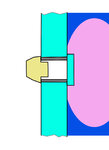flavitie
Newbie level 4
Hi everybody, I am not sure if this post follows the guidelines of the forum nor if it is in the right group, I apologize if not.
I have no clue of electronics design (I work on software design) and I need help to solve the following:
I have to build a sort of fingertip keyboard using light detecting sensor, i.e. to detect when a finger covers up a senor.
The sensor (photo resistor or diode or similar) is mounted on a plastic box as depicted in the attached image where>
yellow is the sensor, cyan is the plastic box, dark grey is opaque coating, blue is water (right part is outside, left part inside the waterproof box), pink is fingertip.
the sensor should be connected to a digital Input port of the raspberry Pi, when the finger covers the sensor the port should detect a a logic High, otherwise low.
there are 10 of such sensor in the box.
Could anyone suggest a design? I would need a complete schematic and component list since I have no electronics knowledge.

Thanks a lot for any support!
F.
I have no clue of electronics design (I work on software design) and I need help to solve the following:
I have to build a sort of fingertip keyboard using light detecting sensor, i.e. to detect when a finger covers up a senor.
The sensor (photo resistor or diode or similar) is mounted on a plastic box as depicted in the attached image where>
yellow is the sensor, cyan is the plastic box, dark grey is opaque coating, blue is water (right part is outside, left part inside the waterproof box), pink is fingertip.
the sensor should be connected to a digital Input port of the raspberry Pi, when the finger covers the sensor the port should detect a a logic High, otherwise low.
there are 10 of such sensor in the box.
Could anyone suggest a design? I would need a complete schematic and component list since I have no electronics knowledge.

Thanks a lot for any support!
F.

